UNIT 1:COMMUNICATION, INTERNATIONAL RELATIONS AND COOPERATION
Key Unit Competence: To use language learnt in the context of Communication, international relations and cooperation
Introductory activity
Picture observation and interpretation
Observe the following pictures and carry out the following tasks
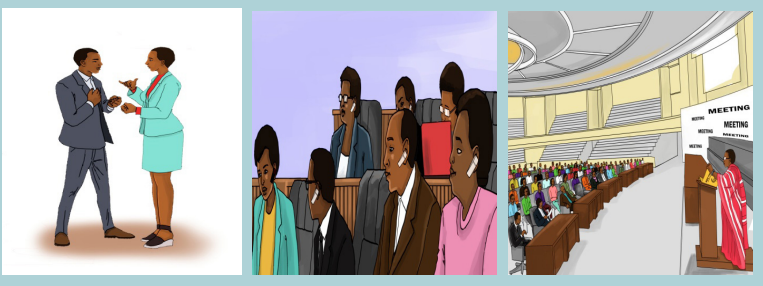
1. What activities do the above pictures portray?
2. How do they relate to communication, international relations and cooperation?
3. Explain the following idioms related to communication:
a. To drop someone a line
b. To get a hold of someone
c. To keep/stay in touch
d. To touch a base
e. To spread by word of mouth
f. To spread like wildfire
g. write to be understood, speak to be heard, read to grow (by Lawrence Clark Powell)
h. Communication is the solvent of problems and is the foundation for personal development (by Peter Shepherd)
i. Communication works for those who work at it (by John Powell )
j. Information is giving out and communication is getting through (by Sydney J. Harris)
1.1. Language related to different types of communication
1.1.1. Learning activities
Reading and text analysis
Read the following passage and answer the questions that follow:
• Text: The meaning of communication
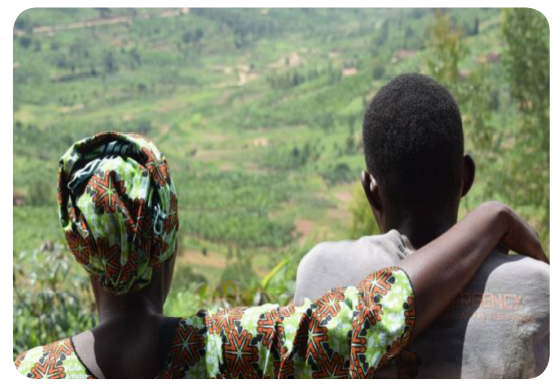
The dictionary defines communication as a process by which information / idea/feeling/attitude is exchanged between individuals through a common system of symbols, signs or behaviour. Gamble (1993) defines communication as a desirable or accidental transfer of meaning. Wilber Schramm defines communication as a mechanism through which human relations exist and develop or sharing of experience on basis of commonness. All in all, communication is a transmission and reception of the message or idea from one party to another in such a way that is mutually understandable. Unless both parties are of one mind as to what the communication means, there is no communication made. Hence, communication is more than a mere transferring of ideas/thoughts. It is a dynamic process of action and interaction towards a desired goal. Communication is as a process of sharing or exchanging ideas, information, knowledge, attitudes or feeling among two or more persons through certain signs, symbols and behaviour.
Note that communication is considered effective only if it achieves the desired reaction or response from the recipient; Involves people: a receiver and a sender; Involves sharing of a meaning. In order for communication to be effective, the receiver and the sender of the message must have a common understanding of the matter at hand, but when both parties don’t have a common understanding, the communication is ineffective. It involves a message which is the purpose of communication taking place and that the message must be symbolic. Due to many barriers of effective communication, it is necessary to use more than one means of communication. The oral communicative language will be in need to be used in forms of telephone, face–to-face discussion, presentation, meetings, conferences, etc. The written communicative language may be in forms of memos, reports, email, notices, minutes, newsletters, forms, advertisements, invitations, questionnaires, press releases, etc. The non-verbal communication in absence of words does not mean that there is no communication because everything we do is a form of communication. The non-verbal communication is anything other than words that communicates a message.
Adapted from Kenyatta University Institute of Open Learning, (2002) Communication skills. Nairobi, Institute of Open Learning-Kenyatta University.
• Comprehension questions
1. Explain how communication is defined by authors in the passage above.
2. What is the main purpose of communication?
3. What indicates that communication is successful?
4. What are the main parties of communication?
5. Explain what communication would be without one of those parties.
6. What are the main types of communication discussed in the above passage?
7. Discuss some types of communication that you use day to day in your class.
1.1.2. Application activity
Vocabulary, summary and composition writing
I. Vocabulary: Use dictionary and thesaurus to check the meaning of
the following words and phrases. Practice spelling them correctly.
1. …Commonness… (paragraph 1)
2. …Mutually… (paragraph 1)
3. …Parties… (paragraph 1)
4. …Mere… (paragraph 1)
5. …Press releases… (paragraph 2)
II. Use the following words and phrases to construct meaningful sentences that relate to communication.
II. Summarize the above passage in not more than 10 lines.
III. Write a 300 word composition describing the types of communication used at school.
1.2. Describing communication elements, functions process
1.2.1. Learning activity
Reading and text analysis
Read the following passage and answer questions that follow:
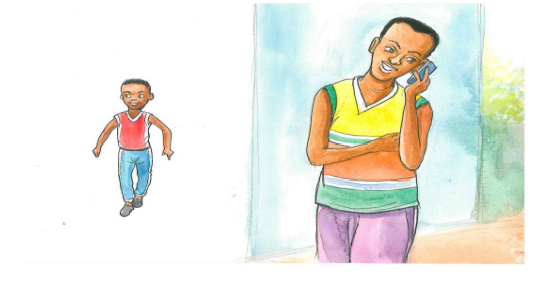
• Text: Elements of communication
In every act or encounter of communication, there are certain common elements that together help define the communication process. If you understand these elements, they will help you to develop your own communication abilities. Communication involves the following elements:
The sender/source of the message (communicator/originator). This refers to the communicator of the message. Communication begins with the sender, who may want to communicate his ideas, needs, intentions or other pieces of information. This sender becomes the receiver of the message at times. The context: This refers to the place and time communication takes place or the situation within which something is explained. The setting or environment influences the way you act towards others or determines the nature or communication encounter you share with them. For example you can change your posture, manner of speaking, or attire due to environment. Message: a message is the physical form of the thought, which can be experienced and understood by one or more senses of the receiver. It could be in the form of hearing, reading or physical gestures. Channel: the channel is the method or medium of transmission of the message from a sender to a receiver. It is a medium carrier and bridges the gap between a sender and a receiver. The message may be oral or written and it may be transmitted through the face-to-face conversation, video, radiotelephone and also through the television, in written form through memos, notices, letter, reports, telegrams, emails or through any form of gestures. Messages may be sent and received through both verbal and non-verbal channels. For effective communication, use more than one channel at any given time. Receiver: the receiver is the person for whom the message is meant; he has to be ready for the message so that it can be decoded in thought. A receiver at times in communication becomes a source or sender. Feedback: when we communicate with one or more persons, we also receive information in return. Verbal or non-verbal cues that we perceive in reaction to our communication are feedback. A feedback determines whether the message was clearly understood and the individual or organizational change has taken place as a result of communication. Feedback can be positive or negative. Feedback completes the communication process
Adapted from Kenyatta University Institute of Open Learning, (2002) Communication skills. Nairobi, Institute of Open Learning-Kenyatta University.
• Comprehension questions
1. What are the elements of communication described in the passage?
2. How does a sender become a receiver at the same time in communication?
Explain this with typical example.
3. How far are these elements of communication applied in your every day communication? Justify it with clear examples.
4. Explain why feedback completes the communication process.
1.2.2. Application activity
Vocabulary, sentence and summary writing
I. Vocabulary: Match the word with its correct meaning in the table below. Remember to spell the words correctly.
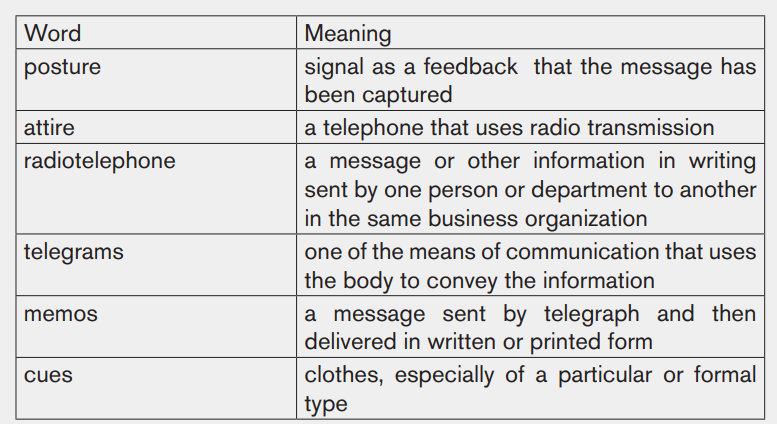
II. Construct meaningful sentences that relate to communication using the above explained words.
III. Write a summary about elements of communication in not more than 10 lines.
Note
• The function of communication
1. Understanding and insight: we depend on communication to develop self-awareness. Communication helps us in understanding ourselves and others. In other words, it makes us to have an insight into ourselves and into others.
2. Meaningful relationships: It is through communication contacts that human beings basic physical and social needs are met. Psychology tells us that you need other people just as you need water, food and shelter. If you are cut from human contact, you become disoriented and maladjusted. Communication offers us the chance to satisfy our needs for inclusion, control and affection.
3. Influence and persuasion: in every communication, people have ample chances to influence each other subtly and overtly. We spend much time trying to persuade one another to think as we think, do what we do, like what we like. After this short consideration of functions of communication, let’s consider the characteristics of good communication
• The process of communication
The process of communication comprises a sender who has a message he/ she transmits through some means (channel) to a receiver who responds. This process can be explained pictorially in form of a model as below:

1.3. Describing international relations and cooperation
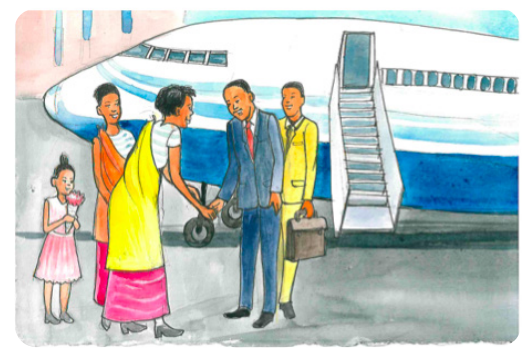
1.3.1. Learning activity
Reading and text analysis
Read the following passage and answer questions that follow:
• Text: Harmonization of education systems and training
The 21st century poses a number of challenges to all societies that will demand that governments and stakeholders enhance integrated investments in education, research and human capital development in order to prepare their citizens to operate effectively in the global economy. The East African Community Partner States have made an explicit decision to cooperate in various spheres of socio-economic and political development. Among these areas of cooperation is education. In this regard, emphasis has been put on capacity building and sharing, joint efforts to develop specialized training facilities, and division of responsibilities in training and research as well as harmonizing of education systems and training curricula within the Partner States of the East African Community.
It is envisaged that when this is realized, the Partner States will have comparable frameworks to promote equal access to education opportunities, harmonized competencies, and harmonized quality assurance and accreditation systems. The attendant benefits of this process as well as the credit transfer modalities and frameworks for students and labour mobility within the EAC region will include provision of better educational services and greater articulation within each of the education systems of the Partner States, among other things.
The desire is driven by the shared vision which is articulated in the EAC Treaty, Article 5 and Article 102. Within these Articles, the treaty provides that the Partner States agree to undertake concerted measures to foster cooperation in education and training within the Community. Therefore harmonization, in this respect, has been conceptualized to direct attention at specific areas of focus within the broad themes of basic education, intermediary education and tertiary education and training programmes that promote the aspirations and objectives of the EAC integration.
For each of the levels/cycles of education and training, the focus of the study has been put on the current status of national education systems, commonalities and significant variances in the national goals of education and training, relevant legal frameworks, progression structure, accreditation of offering institutions, admission criteria, curriculum contents selection, examinations organization and regulations, certification as well as teacher education and training, management and financing strategies and modalities. In addition to the above,consideration has been made of TVET skills and competencies assessment, industrial attachment administration and funding for both local and cross border placements.
In keeping with Sections (d) and (e) of Article 102 of the EAC Treaty on cooperation for the development of adequate and relevant human resources in Science and Technology, Education and Training, this study has looked into the possibilities of developing such programmes in basic, intermediary and tertiary education and adult & continuing education programmes that would promote the emergence of well trained personnel in all sectors relevant to the aims and objectives of the East Africa Community.
To help draw out insights on how best to approach harmonization of EA education and training curricula development and examinations administration systems, certification and accreditation of education and training institutions in the Partner States, the EAC Secretariat offered a consultancy to the Inter-University Council for East Africa, who collected the initial information and views. The report of the Inter-University Council for East Africa was submitted and used, through the joint action of the relevant national stakeholders, committees of experts and bodies charged with the preparation of such curricula, to give views and identify missing critical information for another Consultant to make inputs in order to enrich the Inter-University Council for East Africa Report.
The recommendations contained in this report will be used to plan and undertake appropriate programmes to progressively harmonize the EAC education systems and training curricula by individual Partner States.
Adapted from the regional report on the study of the harmonization of the East African education systems and training curricula.
• Comprehension questions
1. Which measures in the first paragraph have been taken towards education area?
2. What educational areas will be harmonized due to the comparable framework according to the second paragraph?
3. Discuss where the focus has been put for each of the levels/cycles of education and training.
4. What was the purpose of a consultancy to the Inter-University Council for East Africa according to the passage?
5. What will the report’s recommendation help?
6. Justify the positive impact to social economic development when education system of EAC is harmonized.
1.3.2. Application activity
Vocabulary, sentence, summary and essay writing
I. Vocabulary: Use and dictionary and thesaurus to check the meaning of the following words. Practice spelling them correctly.
1. …envisaged… (Paragraph 2)
2. …accreditation... (Paragraph 2)
3. …attendant… (Paragraph 2)
4. …Foster… (Paragraph 3)
5. …Treaty… (Paragraph 3)
6. …Commonalities …( paragraph 4)
7. …Consultancy … ( paragraph 6)
8. …Secretariat … (paragraph 6)
9. …Harmonize… (paragraph 6)
10. …Explicit… ( paragraph 1)
II. Make correct sentences using the above words.
III. Summarize the above passage in not more than 10 lines focusing on the measures taken to harmonize the East African education systems.
IV. Write an essay of 250 words discussing the impact of EAC education system harmonization.
1.4. Treaties and agreements
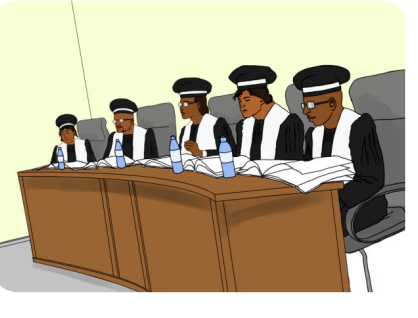
1.4.1. Learning activity
Reading and analysis of the text
Read the following passages and answer questions that follow:
Text 1: International judiciary systems and instruments
The establishment of an international tribunal to judge political leaders accused of international crimes was first proposed during the Paris Peace Conference in 1919 following the First World War by the Commission of Responsibilities. The issue was addressed again at a conference held in Geneva under the auspices of the League of Nations in 1937. This resulted in the conclusion of the first convention stipulating the establishment of a permanent international court to try acts of international terrorism. The convention was signed by 13 states, but none ratified it and it never entered into force.
Following the Second World War, the allied powers established two tribunals to prosecute axis power leaders accused of war crimes. The International Military Tribunal, which sat in Nuremberg, prosecuted German leaders while the International Military Tribunal for the Far East in Tokyo prosecuted Japanese leaders. In 1948 the United Nations General Assembly first recognized the need for a permanent international court to deal with atrocities of the kind prosecuted after the Second World War. At the request of the General Assembly, the International Law Commission (ILC) drafted two statutes by the early 1950s. These were abandoned during the Cold War which made the establishment of an international criminal court politically unrealistic.
In 1994, the ILC presented its final draft statute for the International Criminal Court to the General Assembly and recommended that a conference can be convened to negotiate a treaty that would serve as the Court’s statute. To consider major substantive issues in the draft statute, the General Assembly established the Committee on the Establishment of an International Criminal Court, which met twice in 1995. After considering the committee’s report, the General Assembly created the Preparatory Committee on the Establishment of the international criminal court to prepare a consolidated draft text.
From 1996 to 1998, six sessions of the Preparatory Committee were held at the United Nations headquarters in New York City, during which NGOs provided input and attended meetings under the umbrella organisation of the Coalition for an international criminal court. In January 1998, the Bureau and coordinators of the Preparatory Committee convened for an Inter-session meeting in Zutphen in the Netherlands to technically consolidate and restructure the draft articles into a draft.
Finally, the General Assembly convened a conference in Rome in June 1998, with the aim of finalising the treaty to serve as the court’s statute. On 17 July 1998, the Rome Statute of the International Criminal Court was adopted by a vote of 120 to 7, with 21 countries abstaining. The seven countries that voted against the treaty were China, Iraq, Israel, Libya, Qatar, the United States, and Yemen. Following 60 ratifications, the Rome Statute entered into force on 1 July 2002 and the International Criminal Court was formally established. The first bench of 18 judges was elected by the Assembly of States Parties in February 2003. They were sworn in at the inaugural session of the court on 11 March 2003.
The court issued its first arrest warrants on 8 July 2005, and the first pre-trial hearings were held in 2006. The court issued its first judgment in 2012 when it found Congolese rebel leader Thomas Lubanga Dyilo guilty of war crimes related to using child soldiers.
Adapted from history for Rwandan schools learner’s book senior 5. Rwanda Education Board
Comprehension questions
1. When was the international tribunal court first established?
2. What was its purpose?
3. In which historical era was this international tribunal established?
4. Summarize the failure of this international court according to the above passage.
5. Narrate its success in the last two paragraphs.
Text 2: The International Criminal Tribunal for Rwanda.
International Criminal Tribunal for Rwanda was an international court established in November 1994 by the United Nations Security Council in Resolution 955 in order to judge people responsible for the Rwandan genocide and other serious violations of international law in Rwanda, or by Rwandan citizens in nearby states, between 1 January and 31 December 1994.
In 1995, it became located in Arusha, Tanzania, under Resolution 977. From 2006, Arusha also became the location of the African Court on Human and Peoples’ Rights. In 1998 the operation of the tribunal was expanded in Resolution 1165. Through several resolutions, the Security Council called on the tribunal to complete its investigations by end of 2004, complete all trial activities by end of 2008, and complete all work in 2012.
The tribunal had jurisdiction over genocide, crimes against humanity, and violations of Common Article Three and Additional Protocol II of the Geneva Conventions (which deals with internal conflicts).
As of 2009, the tribunal had finished 50 trials and convicted 29 accused persons, and other 11 trials were in progress and 14 individuals were awaiting trial in detention; but the prosecutor intended to transfer 5 to national jurisdiction for trial. Thirteen(13) others were still at large. . According to the ICTR’s Completion Strategy, in accordance with Security Council Resolution 1503, all first-instance cases were to have completed trial by the end of 2008 (this date was later extended to the end of 2009) and all work was to be completed by 2010. It had been discussed that these goals may not be realistic and were likely to change. The United Nations Security Council called upon the tribunal to finish its work by 31 December 2014 to prepare for its closure and transfer of its responsibilities to the International Residual Mechanism for Criminal Tribunals (IRMCT or Mechanism) which had begun functioning for the ICTR branch on 1 July 2012. As of spring 2015, the Residual Mechanism had taken over much of the operations of the tribunal, and the tribunal announced on 2 February 2015 that it was significantly reducing staff with the goal of wrapping up operations and closing the tribunal by the end of 2015. The Tribunal was officially closed on 31 December 2015.
Adapted from https://en.wikipedia.org/wiki/International Criminal Tribunal for Rwanda
Comprehension questions
1. What was the purpose of establishment of International Criminal Tribunal for Rwanda?
2. Discuss its achievement in 10 lines.
3. Discuss its jurisdiction mentioned in the passage.
4. Explain the end of this tribunal as mentioned in the last paragraph.
1.4.2. Application activity
Vocabulary, sentence and survey report writing
I. Vocabulary: match words with their meaning in the following table.
Remember to practice the spelling of the words.
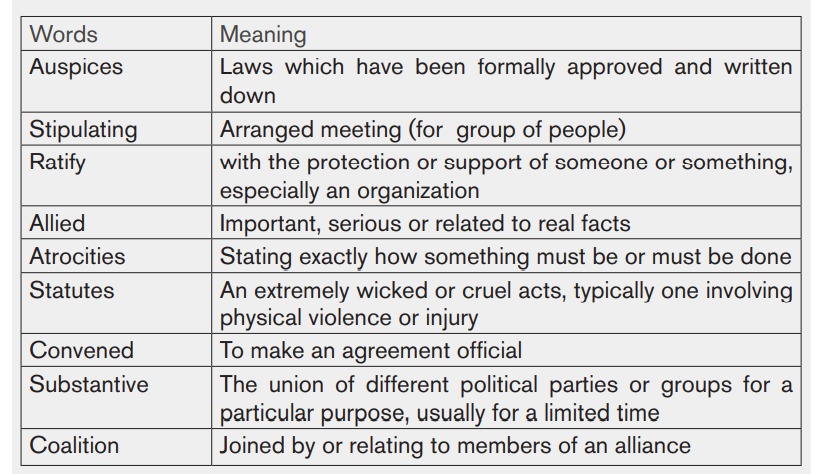
II. With the above mentioned words, make meaningful sentences that are related to international judicial systems.
III. Conduct a survey about some international agreements and write a composition of 350 words about this survey.
1.5. Language structure: Using gerund in clauses
I. Definition:
A gerund is that form of the verb which ends in –ing and used in the same way as a noun.
Examples:
1. Communication is more than a mere transferring of ideas/thoughts
2. Communication is as a process of sharing or exchanging ideas
3. It could be in the form of hearing, reading or physical gestures
4. After considering the committee’s report, the General Assembly created the Preparatory Committee
II. Uses of gerunds
A gerund being a verb-noun may be used as:
a. Subject of a verb
Examples:
1. Judging the perpetrators of crimes committed during the 1994 genocide against Tutsi was the main purpose of International Criminal Tribunal for Rwanda.
2. Harmonizing the EAC system of education was the major concern of the report.
3. Seeing is believing.
b. Object of a transitive verb.
Example:
1. I like reading novels.
c. Object of prepositions coupled with verbs
Examples:
1. Communication is a process of sharing or exchanging ideas.
2. It could be in the form of hearing, reading or physical gestures
3. We talked about going to Canada for vacation
4. Sue is in charge of organizing the meeting
5. I am interested in learning more about your work.
The following is the list of some common verbs followed by gerund:
Admit risk, keep(on) appreciate
fancy consider suggest delay
postpone imagine enjoy discuss
avoid stop mind mention
finish deny quit complete
N.B: The following verbs can be followed by -ing or to ... with no difference of meaning:
begin, start, continue, intend, bother, teach, like, love, prefer, hate, can’t stand, and can’t bear
Examples:

Exercise
Complete each sentence with a preposition and a form of the verb in parentheses.
1. Two children are excited (take)……….their first flight.
2. They have been looking forward (be)…………above the clouds
3. A first-time flyer is worried (fly)…………..in the stormy weather.
4. One passenger is blaming another passenger (spill)……….his coffee
5. A man is complaining (have)……………an aisle seat rather than a window seat.
6. The pilot was late, but he had an excuse (be)……late.
7. The co-pilot will be responsible (fly)…………the plane.
8. Security personnel are prohibiting a woman (get)……….on the flight.
1.6. Sound and spelling
I. Practice the pronunciation of the following words and make their phonetic transcription:
1. Posture
2. Attire
3. Radiotelephone
4. Telegrams
5. Memos
6. Mutually
7. Parties
8. Mere
9. Releases
10. Pronunciation
II. Find in the read passages 10 words ending with the following suffixes: ary ,ery ,ible ,sion ,tion ,ment. Use the dictionary to recognize where the stress is placed.
1.7. End unit assessment
End unit assessment
I. Complete each sentence with one of the following verbs (in the correct form): answer, apply, be, forget, listen, live, lose, make, pay, read, try, use
1. Could you please stop.............. so much noise?
2. I enjoy………… to music.
3. I considered……...for the job, but in the end I decided against it.
4. Have you finished …….the newspaper yet?
5. We need to change our routine. We can’t go on……….. like this.
6. I don’t mind you …….. my phone, but please ask me first.
7. My memory is getting worse. I keep.... ..........things.
8. I’ve put off……. this bill so many times. I really must do it today.
9. What a stupid thing to do! Can you imagine …anybody so stupid?
10. I’ve given up…… to lose weight - it’s impossible.
11. If you gamble, you risk ...... your money.
II. Complete the sentences so that they mean the same as the first sentences.
1. I can do what I want and you can’t stop me.
- You……….what I want.
2. It’s not a good idea to travel during the rush hour.
- It’s better to avoid……. during the rush hour.
3. Shall we paint the kitchen next weekend instead of this weekend?
- Shall we postpone…… until next weekend?
4. Could you turn the music down, please?
- Would you mind…….. … ......... , please?
5. Please don’t interrupt all the time.
- Would you mind ………………….
III. Conduct a survey about international relations in African countries and write an essay justifying their importance to African citizens.
IV. Write an essay explaining the process of an effective communication.
